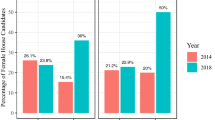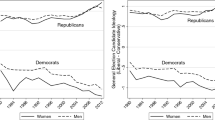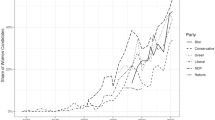Abstract
Are female candidates less likely than male candidates to attract votes or win elections? We conduct a large-n longitudinal analysis employing survey and observational data from every two-party congressional race over a 12-year period (2006–2018) and connect individual-level theory and evidence with aggregate-level results. We demonstrate that candidate gender significantly influences congressional vote-choice and election outcomes. Holding other variables constant, we show that male Republican and male independent voters are significantly less likely to vote for female Democratic candidates, but do not assess a similar penalty on female Republican candidates. Perceived ideological distance does not explain the lack of support for female Democrats—however, variation in candidate quality does: Female Democratic candidates can attract the support of male Republican and male independent voters when they have a qualifications advantage, but are penalized when they are merely “as qualified.” At the aggregate-level, female Democratic candidates with a qualifications advantage are as likely as males to win elections; but are significantly less likely than males to win when qualifications are held constant. The proportion of male Republicans and male independents in a district determines the extent of the penalty, with women’s electoral prospects declining as this proportion increases. Women can win, but they need to be highly qualified and strategic about the races in which they emerge. These findings contribute to our understanding of the micro- and macro-level factors that shape women’s electoral fortunes; and advance the goal of representational equality by helping candidates and campaigns concentrate their efforts on the most winnable voters and districts.
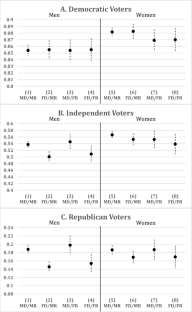
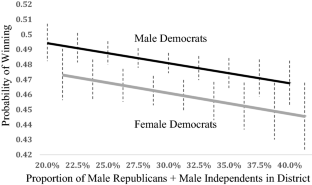
Similar content being viewed by others
Notes
Previous research suggests that women voters can also be sexist (Cassese and Barnes 2018). For instance, white women may adopt sexist beliefs in order to gain acceptance, privilege, and protection from men. Our argument is not that women voters will not be sexist at all, but rather, that they are less likely than men to be sexist due to personal experiences with discrimination and self-interest in gender egalitarian policies.
To be clear, our argument about women’s quality advantage stems not from any kind of “natural superiority” of women candidates. Rather, our theory is rooted in differential competitive pressures faced by male and female candidates, and gendered self-selection.
It is worth noting that this period covers times of good and bad fortune for both parties. Democrats dominated the elections of 2006, 2008, 2012 and 2018; but Republicans fared better than Democrats in 2010, 2014 and 2016. Only for four years (2008–2010 and 2016–2018) was there unified party control of government. Across the period under study, neither party had a distinct advantage.
Uncontested races where the incumbent ran unopposed, and races where two co-partisans ran against each other (e.g. California’s “top-two” primary system occasionally produces general elections with either two Democrats or two Republicans running) are excluded from the analysis.
Online Appendix A provides the summary statistics for all of the variables included in our individual-level models.
We omit respondents who voted for third-party candidates, since we are interested in the two-party vote.
Choosing to code the dependent variable in the direction of Democrats is arbitrary as the two-party vote share adds to 100. Changing the dependent variable to the Republican’s vote-share simply flips the sign of the coefficients in the model, but does not alter the coefficient’s size, significance or any of the other model statistics except for the intercept.
Male (0) or Female (1).
For ease of interpretation in our interactive models, we collapse the seven-point partisanship variable into three categories: − 1 = Strong/Weak/Lean Democrat, 0 = Pure Independent, 1 = Strong/Weak/Lean Republican. Our results remain unchanged if we include partisan leaners as independents.
In years.
White (1) or non-white (0).
Married (1) or not married (0).
Employed full-time (1) or not (0).
College-educated (1) or not (0).
Extremely Liberal (1) to Extremely Conservative (7).
To see whether the gap in relative spending or relative experience contributes more to female Democrats’ disadvantage, we estimate two separate models: one with only relative spending, and one with only relative experience. The female Democratic candidate coefficient emerges as negative and statistically significant in both the models: ß = − 0.13 (p < 0.001) in the model with only relative spending and ß = − 0.05 (p < 0.10) in the model with only relative experience. Although the two variables are significantly correlated (r = 0.74, p < 0.001), they each contribute unique variance when they are included together as shown in Models 2–4 in Table 1.
It is notable that the number of cases drops significantly (from 195 K respondents to a little over 120 K) when the perceived ideological distance measure is included. This is because a large portion of respondents could not place the Democratic candidate on an ideological scale. To evaluate whether these omitted cases were introducing bias, we ran Model 3 without the perceived distance variable. Our results are unchanged when we omit perceived distance: MR + MI voters are significantly less supportive of female than male Democratic candidates. Online Appendix B reports this analysis in greater detail.
An alternative explanation for our findings is that female Democrats are penalized for being more racially diverse than female Republicans. To fully answer whether this question, we would need to know the racial identity of every candidate, which we do not have. As a preliminary test of the racism hypothesis, we evaluate whether white voters are more punitive towards female Democrats than the full sample of voters, but we find that this is not the case. See Online Appendix C for the full analysis.
Uncontested races where the incumbent ran unopposed and races where two co-partisans ran against each other are excluded from the analysis.
Online Appendix D provides the summary statistics for all of the variables included in our models.
References
Abramowitz, A. A., & Webster, S. (2016). The rise of negative partisanship and the nationalization of U.S. elections in the 21st century. Electoral Studies, 41, 12–22.
Alexander, D., & Anderson, K. (1993). Gender as a factor in the attribution of leader-ship traits. Political Research Quarterly, 46(3), 527–545.
Ambrosius, M. M., & Welch, S. (1984). Women and politics at the grassroots: Women candidates for state office in three states, 1950–1978. Social Science Journal, 21(1), 29–42.
Ansolabehere, S. (2010a). CCES common content, 2006. https://doi.org/10.7910/DVN/Q8HC9N, Harvard Dataverse, V4, UNF:5:Zz4+e5bz7lzeLOjQCUk+lw== [fileUNF].
Ansolabehere, S. (2010b). CCES, common content, 2008. https://doi.org/10.7910/DVN/YUYIVB, Harvard Dataverse, V6, UNF:5:7eeaUMPVCcKDNxK6/kd37w== [fileUNF].
Ansolabehere, S. (2012). CCES common content, 2010. https://doi.org/10.7910/DVN/VKKRWA, Harvard Dataverse, V3.
Ansolabehere, S., & Schaffner, B. (2013). CCES common content, 2012. https://doi.org/10.7910/DVN/HQEVPK. Harvard Dataverse, V9, UNF:5:Eg5SQysFZaPiXc8tEbmmRA== [fileUNF].
Ansolabehere, S., & Schaffner, B. F. (2017). CCES common content, 2016. https://doi.org/10.7910/DVN/GDF6Z0, Harvard Dataverse, V4, UNF:6:WhtR8dNtMzReHC295hA4cg== [fileUNF].
Anzia, S. F., & Berry, C. R. (2011). The Jackie (and Jill) Robinson effect: Why do congresswomen outperform congressmen? American Journal of Political Science, 55(3), 478–493.
Arzheimer, K. (2009). Contextual factors and the extreme right vote in Western Europe, 1980–2002. American Journal of Political Science, 53(2), 259–275.
Arzheimer, K., & Carter, E. (2006). Political opportunity structures and right-wing extremist party success. European Journal of Political Research, 45(3), 419–443.
Ashworth, S., Berry. C. R., & de Mesquita, E. B. (2020). Sources of women’s underrepresentation in U.S. Politics: A model of election aversion and voter discrimination. Unpublished manuscript.
Barnes, T. D., Branton, R. P., & Cassese, E. C. (2017). A reexamination of women’s electoral success in open seat elections: The conditioning effect of electoral competition. Journal of Women, Politics and Policy, 38(3), 298–317.
Basinger, S. J., & Lavine, H. (2005). Ambivalence, information, and electoral choice. American Political Science Review, 99(1), 169–184.
Bauer, N. M. (2015). Emotional, sensitive, and unfit for office? Gender stereotype activation and support female candidates. Political Psychology, 36(6), 691–708.
Becker, J. C., & Swim, J. K. (2012). Reducing endorsement of benevolent and modern sexist beliefs: Differential Effects of addressing harm versus pervasiveness of benevolent sexism. Social Psychology, 43(3), 127–137.
Beckwith, K. (2000). Beyond compare? Women’s movements in comparative perspective. European Journal of Political Research, 37(4), 431–468.
Berch, N. (2004). Women incumbents, elite bias and voter response in the 1996 and 1998 U.S. house election. Women & Politics, 26(1), 21–33.
Bernstein, R. A. (1986). Why are there so few women in the house? Western Political Quarterly, 39(1), 155–164.
Black, J. H., & Erickson, L. (2000). Similarity, compensation or difference? A comparison of female and male office-seekers. Women & Politics, 21(4), 1–38.
Bolsen, T., & Thornton, J. R. (2014). Overlapping confidence intervals and null hypothesis testing. The Experimental Political Scientist, 4(1), 12–16.
Bos, A. L., Schneider, M. C., & Utz, B. L. (2018). Navigating the political labyrinth: Gender stereotypes and prejudice in US elections. In C. Travis & J. White (Eds.), APA handbook of the psychology of women. Washington, DC: American Psychological Association.
Burns, N., Schlozman, K. L., & Verba, S. (2001). The private roots of public action: Gender, equality and political representation. Cambridge: Harvard University Press.
Burrell, B. (1985). Women’s and men’s campaigns for the U.S. house of representatives, 1972–1982. A finance gap? American Politics Research, 13(3), 251–272.
Burrell, B. (1994). A woman’s place is in the house: Campaigning for congress in the feminist era. Ann Arbor: University of Michigan Press.
Burrell, B. (2003). Money and women’s candidacies for public office. In S. J. Carroll (Ed.), Women and American politics: New questions, new directions. Oxford: Oxford University Press.
Campbell, A., Converse, P., Miller, W., & Stokes, D. (1960). The American voter. Hoboken, NJ: Wiley.
Carey, T. E., & Lizotte, M. K. (2019). Political experience and the intersection between race and gender. Politics, Groups and Identities, 7(2), 243–266.
Cassese, E. C., & Barnes, T. D. (2018). Reconciling sexism and women's support for republican candidates: A look at gender, class, and whiteness in the 2012 and 2016 presidential races. Political Behavior, 41(3), 1–24.
Cassese, E. C., & Holman, M. R. (2019). Playing the woman card: Ambivalent sexism in the 2016 US presidential race. Political Psychology, 40(1), 55–74.
Caul, M. (2001). Political parties and the adoption of candidate gender quotas: A cross-national analysis. Journal of Politics, 63(4), 1214–1229.
CAWP. (2019). Women general election candidates for U.S. congress and statewide elected executive. Retrieved March 10, 2020, from https://cawp.rutgers.edu/facts/elections/past_candidates.
Converse, P. E. (1964). Ideology and Discontent. Washington, DC: Free Press.
Cooperman, R., & Crowder-Meyer, M. (2018). A run for their money: republican women’s hard road to campaign funding. In M. Och & S. L. Shames (Eds.), The right women: Republican party activists, candidates and legislators. Santa Barbara: ABC-CLIO.
Crowder-Meyer, M., & Lauderdale, B. E. (2014). A partisan gap in the supply of female potential candidates in the United States. Research & Politics, 1(1), 1–7.
Darcy, R., & Schramm, S. S. (1997). When women run against men. Public Opinion Quarterly, 41(1), 1–12.
Darcy, R., Welch, S., & Clark, J. (1994). Women, elections and representation. Lincoln: University of Nebraska Press.
Deckman, M. (2016). Tea party women: Mama grizzlies, grassroots leaders and the changing face of the American right. New York: New York University Press.
Ditonto, T. (2019). Direct and indirect effects of prejudice: Sexism, information, and voting behavior in political campaigns. Politics, Groups and Identities, 7(3), 590–609.
Dittmar, K. (2019). By the numbers. U.S. house candidates, nominees, and winners, by party 1990–2019 CAWP. Retrieved March 10, 2020, from https://womenrun.rutgers.edu/by-the-numbers/.
Dolan, K., & Sanbonmatsu, K. (2009). Gender stereotypes and attitudes towards gender balance in government. American Politics Research, 37(3), 409–428.
Eagly, A. H., & Karau, S. J. (2002). Role congruity theory of prejudice toward female leaders. Psychological Review, 109(3), 573–598.
Economist/YouGov. (2018). Economist/YouGov Poll, April 22–24, 2018, 1500 U.S. adults. Retrieved March 10, 2020, from https://d25d2506sfb94s.cloudfront.net/cumulus_uploads/document/a849k68e2i/econTabReport.pdf.
Erikson, R. S., MacKuen, M. B., & Stimson, J. A. (2002). The macro polity. New York: Cambridge University Press.
Evans, J. A. J. (2005). The dynamics of social change in radical right-wing populist party support. Comparative European Politics, 3(1), 76–101.
Fox, R. L., & Lawless, J. L. (2005). To run or not to run for office: Explaining nascent political ambition. American Journal of Political Science, 49(3), 642–659.
Fox, R. L., & Smith, E. R. A. N. (1998). The role of candidate sex in voter decision-making. Political Psychology, 19(2), 405–419.
Fulton, S. A. (2012). Running backwards and in high heels: The gendered quality gap and incumbent electoral success. Political Science Quarterly, 65(2), 303–314.
Fulton, S. A. (2014). When gender matters: Macro-dynamics and micro-mechanisms. Political Behavior, 36(3), 605–630.
Fulton, S. A., Maestas, C. D., Sandy Maisel, L., & Stone, W. J. (2006). The sense of a woman: Gender, ambition and the decision to run for congress. Political Research Quarterly, 59(2), 235–248.
Fulton, S. A., & Ondercin, H. L. (2013). Does sex encourage commitment? The impact of candidate choices on the time-to-decision. Political Behavior, 35(4), 665–686.
Givens, T. E. (2004). The radical right gender gap. Comparative Political Studies, 37(1), 30–54.
Green, D., Palmquist, B., & Schickler, E. (2002). Partisan hearts and minds: Political parties and the social identities of voters. New Haven, CT: Yale University Press.
Green, D. P., & Krasno, J. S. (1988). Salvation for the spendthrift incumbent: Reestimating the effects of campaign spending in house elections. American Journal of Political Science, 32(4), 884–907.
Hennings, V. M., & Urbatsch, R. (2015). There can be only one (woman on the ticket): Gender in candidate nominations. Political Behavior, 37(3), 749–766.
Holman, M. R., Merolla, J. L., & Zechmeister, E. J. (2016). Terrorist threat, male stereotypes and candidate evaluation. Political Research Quarterly, 69(1), 134–147.
Huddy, L., & Terkildsen, N. (1993a). The consequences of gender stereotypes of women candidates at different levels and types of office. Political Research Quarterly, 46(3), 503–526.
Huddy, L., & Terkildsen, N. (1993b). Gender stereotypes and the perception of male and female candidates. American Journal of Political Science, 37(1), 119–147.
Hughes, M. M., & Paxon, P. (2007). Familiar theories from a new perspective: The implications of a longitudinal approach to women in politics research. Politics & Gender, 3(3), 370–378.
Jackman, M. R. (1994). The velvet glove: Paternalism and conflict in gender, class, and race relations. Berkeley: University of California Press.
Jacobson, G. C., & Kernell, S. (1983). Strategy and choice in congressional elections. New Haven, NJ: Yale University Press.
Jenkins, S. (2007). A woman’s work is never done? Fund-raising perception and effort among female state legislative candidates. Political Research Quarterly, 60(2), 230–239.
Kahn, K. F. (1994). Does gender make a difference? An experimental examination of sex stereotypes and press patterns in statewide campaigns. American Journal of Political Science, 38(1), 162–195.
Kahn, K. F. (1996). The political consequence of being a woman: How stereotypes influence the conduct and consequences of political campaigns. New York: Columbia University Press.
Koch, J. W. (2000). Do citizens apply gender stereotypes to infer candidates’ ideological orientations? Journal of Politics, 62(2), 414–429.
Koch, J. W. (2002). Gender stereotypes and citizens’ impressions of house candidates’ ideological orientations. American Journal of Political Science, 46(2), 453–462.
Lawless, J. L. (2015). Female candidates and legislators. Annual Review of Political Science, 18(1), 349–366.
Lawless, J. L., & Pearson, K. (2008). The primary reason for women's underrepresentation? Reevaluating the conventional wisdom. The Journal of Politics, 70(1), 67–82.
Lazarus, J., & Steigerwalt, A. (2018). Gendered vulnerability: How women work harder to stay in office. Ann Arbor: University of Michigan Press.
Lenz, G. (2012). Follow the leader? How voters respond to politicians’ policies and performance. Chicago, IL: University of Chicago Press.
Levendusky, M. (2009). The partisan sort: How liberals became democrats and conservatives became republicans. Chicago, IL: University of Chicago Press.
Lubbers, M., & Scheepers, P. (2002). French front National voting: A micro and macro perspective. Ethnic and Racial Studies, 25(1), 120–149.
Lucassen, G., & Lubbers, M. (2012). Who fears what? Explaining far-right-wing preference in Europe by distinguishing perceived cultural and economic ethnic threats. Comparative Political Studies, 45(5), 547–574.
Mansbridge, J. J. (1986). Why we lost the ERA. Chicago, IL: University of Chicago Press.
McDermott, M. L. (1997). Voting cues in low-information elections: Candidate gender as a social information variable in contemporary United States Elections. American Journal of Political Science, 41(1), 270–283.
McDermott, M. L. (1998). Race and gender cues in low-information elections. Political Research Quarterly, 51(4), 895–918.
Mendelberg, T., & Karpowitz, C. F. (2016). Power, gender, and group discussion. Political Psychology, 37, 23–60.
Mendez, J. M., & Osborn, T. (2010). Gender and the perception of knowledge in political discussion. Political Research Quarterly, 63(2), 269–279.
Milyo, J., & Schosberg, S. (2000). Gender bias and selection bias in house elections. Public Choice, 105(1/2), 41–59.
Nicholson, S. P. (2011). Dominating cues and the limits of elite influence. Journal of Politics, 73(4), 1165–1177.
Niederle, M., & Vesterlund, L. (2007). Do women shy away from competition? Do men compete too much? The Quarterly Journal of Economics, 122(3), 1067–1101.
Niven, D. (2006). Throwing your hat out of the ring: Negative recruitment and the gender imbalance in State Legislative Candidacy. Politics and Gender, 2(4), 473–489.
O’Brien, D. Z. (2018). Righting conventional wisdom: Women and right parties in established democracies. Politics & Gender, 14(1), 27–55.
O’Brien, D. Z., & Rickne, J. (2016). Gender quotas and women’s political leadership. American Political Science Review, 110(1), 112–126.
Ondercin, H., & Welch, S. (2009). Comparing predictors of women’s congressional election success: Candidates, primaries, and the general election. American Politics Research, 37(4), 593–613.
Ondercin, H. L., & Fulton, S. A. (2019). Bargain shopping: How candidate sex lowers the cost of voting. Politics & Gender. 1–27.
Ono, Y., & Burden, B. C. (2019). The contingent effects of candidate sex on voter choice. Political Behavior, 41(3), 583–607.
Palmer, B., & Simon, D. (2006). Breaking the political glass ceiling. New York: Routledge.
Payton, M. E., Greenstone, M. H., & Schenker, N. (2003). Overlapping confidence intervals or standard error intervals: What do they mean in terms of statistical significance? Journal of Insect Science, 3(1), 34.
Pearson, K., & McGhee, E. (2013). What it takes to win: Questioning “gender neutral” outcomes in U.S. house elections. Politics & Gender, 9(4), 439–462.
Peterson, E. (2017). The role of the information environment in partisan voting. Journal of Politics, 79(4), 1191–1204.
Popkin, S. L. (1991). The reasoning voter: communication and persuasion in presidential campaigns. Chicago, IL: University of Chicago Press.
Rahn, W. M. (1993). The role of partisan stereotypes in information-processing about political candidates. American Journal of Political Science, 37(2), 472–496.
Sanbonmatsu, K. (2002a). Democrats/republicans and the politics of women’s place. Ann Arbor: University of Michigan Press.
Sanbonmatsu, K. (2002b). Gender stereotypes and vote choice. American Journal of Political Science, 46(1), 20–34.
Schaffner, B., & Ansolabehere, S. (2015). CCES common content, 2014. https://doi.org/10.7910/DVN/XFXJVY, Harvard Dataverse, V4, UNF:6:WvvlTX+E+iNraxwbaWNVdg== [fileUNF].
Schaffner, B., Ansolabehere, S., & Luks, S. (2019). CCES common content, 2018. https://doi.org/10.7910/DVN/ZSBZ7K, Harvard Dataverse, V5, UNF:6:hFVU8vQ/SLTMUXPgmUw3JQ== [fileUNF].
Schaffner, B. F., Macwilliams, M., & Nteta, T. (2018). Understanding white polarization in the 2016 vote for president: the sobering role of racism and sexism. Political Science Quarterly, 133(1), 9–34.
Schneider, M. C., & Bos, A. (2016). The interplay of candidate party and gender in evaluations of political candidates. Journal of Women Politics and Policy, 37(3), 274–294.
Schreiber, R. (2008). Righting feminism: Conservative women and american politics. Oxford: Oxford University Press.
Seltzer, R., Newman, J., & Leighton, M. V. (1997). Sex as a political variable: Women as candidates and voters in US elections. Boulder, CO: Lynn Reinner.
Shames, S. L. (2018). Higher hurdles for republican women: Ideology, inattention, infrastructure. In M. Och & S. L. Shames (Eds.), The right women: Republican party activists, candidates and legislators. Santa Barbara: Praeger Press.
Swers, M. (2018). From the republican revolution to the tea party wave: Republican women and the politics of women’s issues. In M. Och & S. L. Shames (Eds.), The Right women: Republican party activists, candidates and legislators. Santa Barbara: Praeger Press.
Swim, J. K., Aikin, K. J., Hall, W. S., & Hunter, B. A. (1995). Sexism and racism: Old fashioned and modern prejudices. Journal of Personality and Social Psychology, 68(2), 199–214.
Thomsen, D. M. (2018). Republican women, then and now: Ideological changes in congressional candidates from 1980 to 2012. In M. Och & S. L. Shames (Eds.), The right women: Republican party activists, candidates and legislators. Santa Barbara: Praeger Press.
Uhlander, C. J., & Schlozman, K. L. (1986). Candidate gender and congressional campaign receipts. Journal of Politics, 48(1), 30–50.
Valdini, M. E. (2019). The inclusion calculation: Why men appropriate women’s representation. Oxford: Oxford University Press.
Volden, C., Wiseman, A. E., & Wittmer, D. E. (2013). When are women more effective lawmakers than men? American Journal of Political Science, 57(2), 326–341.
Wolbrecht, C. (2000). The politics of women’s rights: Parties. Positions and Change: Princeton University Press.
Author information
Authors and Affiliations
Corresponding author
Additional information
Publisher's Note
Springer Nature remains neutral with regard to jurisdictional claims in published maps and institutional affiliations.
We owe a sincere debt of gratitude to Gary Jacobson for generously sharing his data on congressional elections. Our paper has benefited from suggestions from the Political Behavior and Institutions Group at Texas A&M and the American Politics Research Group at UC Berkeley. We are thankful to the editors and reviewers for their insights and constructive comments. A previous version of this paper was presented to the Western Political Science Association in March 2019, at which it won the Betty Nesvold Award for the Best Paper on Women in Politics. We thank the members of the award committee for taking the time to read and comment on our work. The data and all computer code necessary to replicate the results in this analysis will be made available on our websites at sarahfulton.org and kdhima.com on publication. Stata 13 was the statistical package used in this study.
Electronic supplementary material
Below is the link to the electronic supplementary material.
Rights and permissions
About this article
Cite this article
Fulton, S.A., Dhima, K. The Gendered Politics of Congressional Elections. Polit Behav 43, 1611–1637 (2021). https://doi.org/10.1007/s11109-020-09604-7
Published:
Issue Date:
DOI: https://doi.org/10.1007/s11109-020-09604-7


